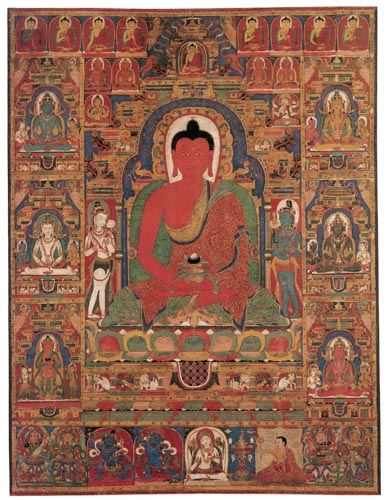
มูลนิธิพันดารา
ขอเชิญเข้าร่วมพิธีมนตราภิเษก
พระอมิตายุสพุทธเจ้า
เพื่อความมีอายุยืนยาว
(Long Life Empowerment)
พระอาจารย์ผู้ประกอบพิธี:
แมงเกีย ลาเซ ริมโปเช
ผู้แปล: รศ. ดร. กฤษดาวรรณ หงศ์ลดารมภ์
วันอาทิตย์ที่ 17 ธันวาคม พ.ศ. 2549
ไร่รักธรรมะ-ชาติ ต. หนองพลับ อ. หัวหิน จ. ประจวบคีรีขันธ์
แจ้งความจำนงได้ที่ รศ. ดร. กฤษดาวรรณ หงศ์ลดารมภ์ หรือนางอารีรัตน์ ศิริคูณ
โทร 081-343-1586 โทรสาร 02-2184755, 02-5285308
E-mail: krisadawan@thousand-stars.org หรือ areeratana@thousand-stars.org
พระพุทธเจ้าอมิตายุสทรงเป็นสัมโภคกาย หรือกายอันรื่นรมย์ของพระพุทธเจ้าอมิตาภะ ทรงเป็นพระพุทธเจ้าแห่งความมีอายุยืนยาว สถิตอยู่ ณ แดนพุทธเกษตรสุขาวดี พรของพระองค์ได้แก่การที่เรามีอายุยืนยาว เพื่อที่จะได้มีเวลาในชีวิตมากขึ้นในการปฏิบัติธรรม และสั่งสมบุญกุศลอันจะเป็นเหตุให้เราได้มีโอกาสได้ทำงานเพื่อประโยชน์แก่สรรพสัตว์ได้มากยิ่งขึ้น พระองค์ทรงถือคณโฑน้ำอมฤต ซึ่งเป็นสัญลักษณ์ของการมีอายุยืนยาว การเข้าร่วมพิธีนี้จะช่วยให้ผู้เข้าร่วมพิธีมีอายุยืนยาวมากขึ้น ตราบเท่ากับอายุขัยของตนเอง
พระอาจารย์ผุ้ประกอบพิธี ได้แก่แมงเกีย ลาเซ ริมโปเช เป็นพระอาจารย์องค์สำคัญที่สุดองค์หนึ่งของพระพุทธศาสนาในทิเบต ริมโปเชเป็นพระอาจารย์ในสายซกเช็น ซึ่งเน้นที่การเข้าถึงสภาพเดิมแท้ของใจที่ใสกระจ่าง ปราศจากการปรุงแต่งใดๆ ลาเซ ริมโปเชได้เดินทางมายังประเทศไทยเพื่อมาให้พรแก่ภัทรกัลป์ตาราขทิรวัณ อันเป็นพื้นที่ที่มูลนิธิพันดารามีโครงการจะสร้างสถูป รวมทั้งห้องสมุดและสถานปฏิบัติธรรมตามแบบของพระพุทธศาสนาวัชรยาน มูลนิธิพันดารารู้สึกเป็นเกียรติอย่างยิ่ง ที่ลาเซ ริมโปเชได้มีเมตตา ประกอบพิธีมนตราภิเษกเพื่อมีอายุยืนในครั้งนี้ เนื่องจากท่านเป็นพระอาจารย์สายปฏิบัติที่ไม่สนใจเรื่องการสอนให้แก่คนหมู่มาก แต่ท่านก็เห็นความมีศรัทธากับความรักเคารพในครูอาจารย์ของคนไทย และประทับใจคนไทยกับประเทศไทยเป็นอย่างมาก ท่านจึงยินดีประกอบพิธีมนตราภิเษกในครั้งนี้ จึงนับว่าเป็นโชคดีของคนไทยเป็นอย่างยิ่ง



